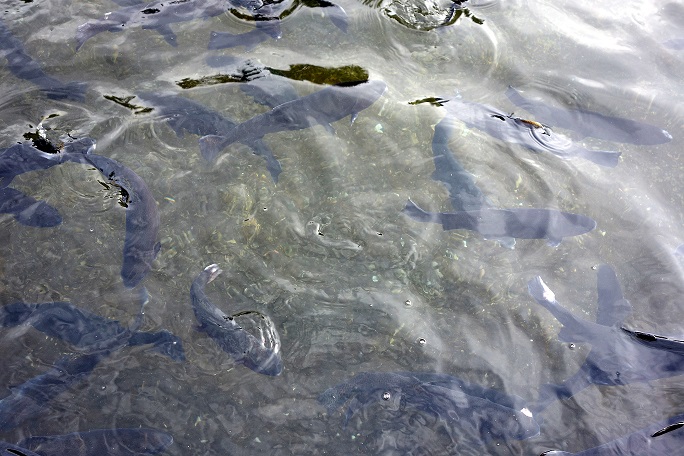Introducing guest writer Emily Folk! Emily contacted me and asked if she could contribute to Ocean Wild Things. After taking a look at her fabulous website Conservation Folks, I naturally responded, of course! Emily’s goal is to help people become more informed about the world and how we fit into it. If you would like to learn more about her, check out the bio on her website. In the meantime, enjoy reading her first article on the challenges of aquaculture.
Washington’s Salmon Spill and the Aquaculture Challenge
By Emily Folk
Aquaculture can be beneficial, but there are some issues that have to be fixed.
The world’s population is increasing, which means there will be more hungry people to feed. To ensure we can feed everyone and sustain our world, we need to develop and refine techniques for raising food. Aquaculture has the ability to help produce a cheap protein source for people to enjoy, but there are some problems.
Recently, an unknown number of salmon escaped from an aquaculture farm in Washington State into the wild population. This is problematic, of course, because no one knows what kind of impact these fish will have on the natural environment. It’s possible they can compete with wild populations for food or become an invasive species and push wild salmon to the brink of extinction. The goal is to get them out of the environment before damage can be done. This escape has highlighted aquaculture practices and made the rest of the world wonder if fish farming is the answer to producing more fish.
What Is the Future of Fish Farming?
The fish escape in Washington brought to light that the aquaculture industry needs to change. It has the potential to produce a lot of food for a lot of people, but it has to be done in an ecological and sustainable way. One way to ensure fish can’t escape is to monitor cages and fish populations using underwater drones. This will alert the companies that there is a problem before it turns into a catastrophe.
It’s also important to continue to conduct studies to determine best practices for housing fish and feeding them. As technology advances, fish farms should find more efficient and effective ways to raise fish and feed an ever-increasing world population. This is incredibly important in ensuring that wild fish populations aren’t fished into oblivion, which is a distinct possibility with the world’s desire to eat seafood.
What Criticisms Has the Escape Raised About Aquaculture?
There are many criticisms about fish farming, including those that focus on how the fish are raised and fed and whether they are healthy for human consumption. There’s also a worry that the fish kept in open pens in fresh or saltwater will have an impact on wild populations.
When it comes to growing fish for food, there are a variety of ways it can be accomplished. Large tanks can be constructed to house the fish populations, or open pens can be used to keep fish in fresh or saltwater areas. It’s even possible to raise fish for food in your backyard.
The variety of enclosures to house fish raises different questions. For those kept in tanks, the question of how clean the environment is for fish is often raised. In crowded cages, it’s more difficult to clean up waste, and with so many fish in one area, diseases can spread easily from one animal to another. This is usually combated with antibiotics, so then the question becomes how safe is antibiotic use for fish and humans.
For open tanks in freshwater and the ocean, some worry the farmed fish will spread disease to wild populations or that their waste will alter the natural environment. There is also the question of feed for farmed fish and if that gets into the wild population, will it change the eating habits of wild fish? Then, there is also the worry about what will happen to the environment if any of the farmed fish escape. At the moment, there aren’t many concrete answers to these concerns.
At its heart, aquaculture has the best intentions to provide protein to a growing population at an affordable price. There are some issues with how the companies operate, but with cooperation and advancements in technology, it’s possible to overcome these obstacles and create a sustainable practice that will impact the world in a positive way.
How to Find Sustainably Farmed Fish
So you might be wondering how do you find sustainably farmed fish and avoid the negative affects of non-sustainable fish farming? Well, you might be surprised to learn that sustainable seafood is not hard to find. Stores like Target, Safeway, Wegmans and Whole Foods all carry sustainably farmed fish.
Monterey Bay Aquarium also developed a Seafood Watch app that provides sustainable seafood recommendations. The app lets you search for the type of fish you want, like salmon. It then gives you a report of the best fish, the method of how they’re caught, and where the fish is available. Seafood Watch also tells you good alternatives if the best choices are not readily available as well as which types to avoid.
Finding sustainably farmed fish may seem like a daunting task, but there are definitely options available, and with the technology resources we have today, there’s a lot of help out there if you go looking for it. The most important thing is just to make sure you’re aware of where your fish is coming from and how it was farmed.

Welcome to the Ocean Wild Things family, Emily, thanks for the informative article.